
Piquet is thought to be the one of the oldest games of cards still played today largely in its original form. Originally a French pastime, this game is known to have been played in France well over 450 years ago.
Piquet, also sometimes called Pick-It, Cent or Pickett is designed for two players and uses a special 32 card deck. This deck is a subset of the standard deck containing one card in each of the four standard suits of the following denominations; Ace, King, Queen, Jack, 10, 9, 8 and 7. The ranking of these cards is as follows from low to high; 7, 8, 9, 10, Jack, Queen, King, Ace.
The first order of business when starting a new game of Piquet is to determine the first dealer. This is usually done by having both players cut a card from a face down and shuffled deck. The player drawing the lower ranked card becomes the first dealer. If both players draw cards of the same rank the players should draw new cards, continuing to do this until one of the players draws a lower card at which time he takes the role of the first dealer (called mineur). Thereafter the deal alternates back and forth between the two players.
After the first dealer is thus determined, the dealer thoroughly shuffles the deck and offers it to his opponent (called majeur) to cut.
The deal begins with distributing 12 cards to each player in packets of two face down cards, beginning with his opponent. After both players have 12 card hands, the dealer then places the remaining eight cards in the center of the table face down as the stock pile, also called a talon. Traditionally, this pile was set in two smaller piles side by side, one containing five cards and another containing three, but this is rare in modern games of Piquet.
There are three distinct phases to the game of Piquet; The discard and draw, Declaring and Play.
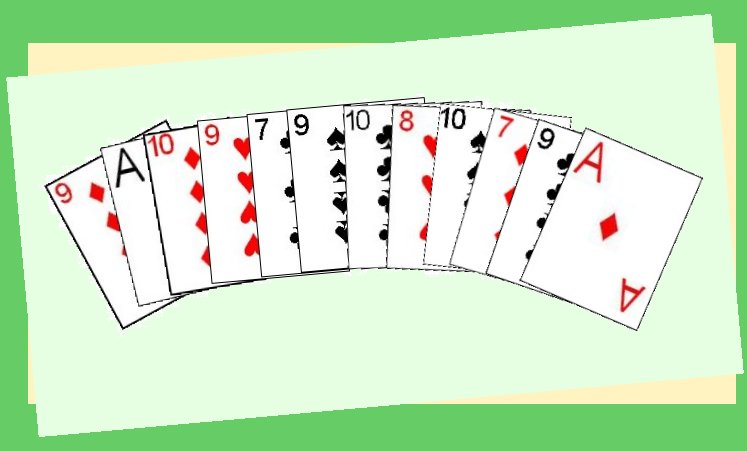
|
| A starting hand containing no Kings, Queens or Jacks is called Carte Blanche which earns the player 10 points. |
Carte Blanche: After receiving their cards both players then examine their hands. If a player has a hand, before the draw, that contains no royalty cards (Kings, Queen, Jack) they are said to have Carte Blanche. If the non-dealer has such a hand, they immediately state this and collect 10 points instantly. The dealer can also make this declaration and score appropriately, however they would wait until after the non-dealer performs the discard and draw portion of their hand. In order to verify or prove that a player has Carte Blanche when declaring it, the declaring player would then briefly expose his hand on the table.
Discard and Draw: The first phase of a hand consists of the Discard and Draw. This is where the players will discard a number of cards from their hand and replace them from the stock pile. Non-dealer has the privilege of being the first to make his discard and draw. To do so, he may discard up to five cards and sets them aside where they will take no further part in the hand. The player must discard at least one card. After discarding he then takes an equal number of cards from the stock to replace the cards discarded.
If the non-dealer takes fewer than the five allowable, he may view any of those five that he did not take, but does not show these cards to the dealer.
After the non-dealer finishes his draw, the dealer than has the opportunity to draw and discard. The dealer is not obligated to make any discards, but may take as many cards as remain in the stock pile. He does this in the same manner as the non-dealer, first placing the cards face down aside (not to be used further in the hand) and then draws an equal number of cards from the stock. If the player elects not to take all the remaining cards in the stock, he may, at his option, expose them for both he and his opponent to view. Otherwise he may not view these cards.
Each player should clearly announce how many cards he is discarding and drawing. In order to assist his memory, a player may look at his own discards anytime during the game, but the cards may never be used in any portion of the hand once discarded.
Declaration:
After the draw and discard phase, the players then begin the Declaration phase. In this phase, the players will declare their holding in three categories in an effort to score points. Whichever player has the highest holding in a given category can score in the category. The categories are declared in the following order: Point, Sequence, Set.
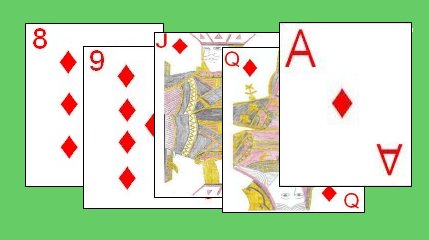 |
| The Player with the most cards in a single suit wins for the Point category |
The first declaration category is
Point. To begin, the non-dealer starts by declaring or announcing the number of cards he holds in his longest (and potentially highest) suit. Thus, if a player had 5 cards in the suit of spades, he might announce "5". If the dealer does not have a suit of the same length or greater, he would say "Good", at which time the non-dealer would score for Point. However, if the dealer has a suit longer than that declared by the non-dealer he would state "No Good" and would instead himself score for Point. If the dealer has a suit of the same length as that of the non-dealer, he would state "How Much?". At this point, both players would add up the total pip value of all cards in their longest, declared suit. For this purpose, Aces count 11, face cards 10 and all others their marked pip value. Whichever player has the highest total pip value of cards in there longest suit would then score for the Point category. However, if both players tie for the length and sum total, neither player scores for this category in the hand. Whichever player is thus determined to score for Point, earns 1 point for each card in that longest suit.
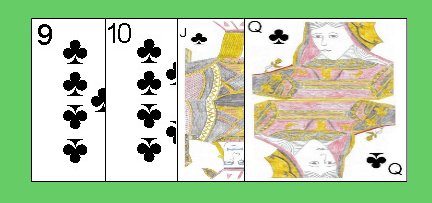 |
| The Player with the longest sequence of consecutive cards in the same suit wins in the Sequence category |
|
The next category to be declared is
Sequence. A sequence is a players longest single suit sequence consisting of at least three cards in consecutive order. As before the non-dealer speaks first. If he holds no such sequence of three or more cards, he simply states "No sequence" at which time the non-dealer might then score for the category. If however, he does hold a sequence he would then declare its total length. As in the previous category, the non-dealer would then respond. If he has no sequence that is equal or longer in length than the non-dealer, he would say "Good" and the non-dealer would earn the score for this category. If, however, he holds a longer sequence he would say "No Good" and himself score for the category. If he has a sequence of equal length, he would state "How Many?". In this case, whichever players longest sequence had a higher top card of the sequence would earn the points for the category. If both players have sequences containing similarly ranked cards or neither player has a sequence of at least three cards, no score would be obtained for the category on this hand.
The score obtained by the highest sequence in the category is dependent on the number of cards in the sequence. A player would score three points for a 3 card sequence, 4 for a four card sequence and for longer sequences would earn 10 points plus one point per card in the sequence. In addition, using the same scoring mechanism the winner in this category could score for any additional sequences held in their hand.
When declaring a sequence, a player usually addresses them as tierce for 3, quart for 4, quint for 5, sixième for 6, septième for 7 and huitième for 8.
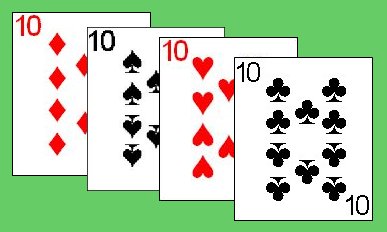 |
| A player scoring for the Set category must hold the longest or highest set of identically ranked cards |
The last category to be declared is
Set. A set in Piquet is a combination of three or more equally ranked cards of pip value 10 or higher. As in the other categories, the non-dealer begins by stating the length of his longest set (3 or 4). If he does not have such a combination in his hand, he would say "No Sets", and the dealer would then have the potential opportunity to score for the Set category. After the non-dealer states his declaration in the category, the dealer would respond as usual. If the dealer has a longer such set, he would immediately score for the category. If both players have equal length sets, the set consisting of higher denomination cards scores for the category. If neither player holds 3 or more equally ranked cards (of denomination 10 or higher) no one scores for the category. The points earned by the winner in this category depend on how many cards in the set. A set of 3 (called a trio) scores 3 points and a set of 4 (called a quatorze) scores 14. A player who wins this category may also score for any additional sets (of face value 10 or better) he possesses.
A player, on his declaration is never obligated to declare his highest holding if, for various strategic reasons he elects not to. He could either declare a lower number or combination than he actually holds or he could elect to indicate he has no such combination. This is commonly called sinking. This would normally be done by a player when trying to conceal the contents of his hand for the play of the hand. However, if he discovers, after his opponents declaration that he may have had a higher holding in the category he cannot score for it.
Although usually unnecessary as it can often be inferred, on demand a player must show the combination of cards for which he declared and had scored.
If after the declaration, a player scores 30 points (including possible scores for Carte Blanche) before his opponent has scored any, he earns a 60 point bonus, called repic.
The Play: After the declaration phase is completed the game then moves to the Play phase. Before beginning this phase, each player (starting with the non-dealer) announces their current point total. In addition, after each trick in the play phase, both players should announce their current score total.
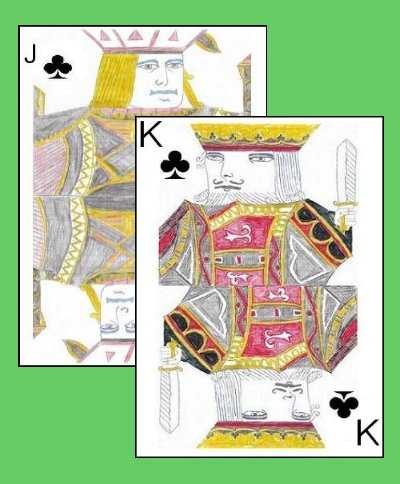 |
| A trick in Piquet is won by the highest card of the suit led. |
Non dealer leads to the first trick with his opponent following with a card of his own. He must play a card of the same suit led to the trick if able. However, if he does not have a card of the led suit, he may play any card. Each trick is won by the highest card of the suit led to it.
The winner of each trick leads to the next. This continues until all 12 tricks have been played.
During the play phase, the players have the opportunity to score points as follows:
- Each lead to a trick scores one point for the player who leads to it.
- Winning a trick to which the opponent led earns one point.
- Winning all 12 tricks earns the winner 40 bonus points (called capot).
- Winning 7, 8, 9, 10 or 11 tricks earns the winner 10 bonus points.
- Winning the last trick earns the winner 1 point. However, a player earning capot does not also get the point for last trick.
If during or after the play phase of the hand, a player earns 30 or more total points in the hand while his opponent still has zero, that player instantly earns a bonus of 30.
Winning the Game: The first player to accumulate 100 or more points is instantly declared the winner.
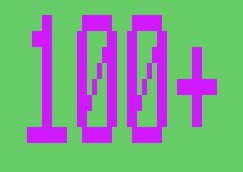 Rubicon Piquet
Rubicon Piquet: The version of Piquet most commonly played today is called Rubicon Piquet. This version is played similarly to the standard version however a game
(or partie) consists of exactly six deals. After the sixth deal, the game winner and final scores are determined. The winner is, of course being the player who scored the higher number of points. If the player with the lower score after
completion of the six deals has failed to reach at least 100 points (known as being rubiconed, regardless of the score of his opponent) the winner earns a final score equal to the sum of both scores added together (with an additional 100 point "Game" score also added). On the other hand, if the player with the lower score manages to score 100 or more total points over the course of the game, the winner (player with the higher total score) earns a final score equal to the difference between his score and that of his opponent, plus a 100 point "Game" bonus.
Rubicon Four Deal Piquet: This variation is identical to Rubicon Piquet, however only 4 deals are played per game. The scores in the first and last deals are doubled.
Trick Scoring Differences: Variations of Piquet that are sometimes played revolve around differences in how points are scored from the winning of tricks. In some game, the point is only awarded from winning or leading to a trick if the led card was a 10, Jack, Queen, King or Ace.
Sink Rule: Another variation which is sometimes seen with Rubicon Piquet regards the rules when sinking. In the normal game, if a players chooses not to declare his highest holding in a category he may not later score for it regardless if he actually had the highest in that category. In this variation, however, if at the end of the game it is discovered that a player who may not have won a particular category during the declaration is found to actually have the highest holding, he would then earn the score for the category. Thus the appropriate amount would be subtracted from his opponents score and added to his own.
Piquet Normand (Three Player Piquet): This is a variation of Piquet for three players. Determination of the first dealer would be done using the normal procedures (cutting for low card), with the deal rotating in a clockwise direction after each hand. Each deal consists of 10 card hands to each of the three players. The remaining two cards are placed face down in the center of the table as a stock. Dealer may opt to take the two card hand, but if he chooses to, must take both cards after discarding two face down (which are not used in the remainder of the hand). If the dealer refuses these cards, no one else may exchange for them. Player to dealers immediate left leads to the first trick.
The player to the dealers immediate left begins the declarations, and the responses continue in a clockwise direction. Thus the second player to the dealers left has first response, and only after he has declared a higher holding or accepted the first players may the dealer make his own call. Only one player may score for any particular category using the same criteria as in standard Piquet.
In this version repic is worth 90 points and can occur if one player scores 20 before the other two score any at the completion of the declaration phase. Similarly, pic earns 60, which can be scored if one player scores 20 during the play phase, before either of the others scores any during the hand. Instead of a score for winning 7, 8, 9, 10 or 11 tricks, whichever player who wins the most tricks scores 10 for game. If two players tie for the most tricks, they would each earn 5 instead, unless the third player won no tricks, in which they would each get 20. Capot remains unchanged, however, earning 40 for a player who manages to win all the tricks.
Piquet Voleur (Four Hand Piquet): This is a version of Piquet designed for four players, who play in two partnerships. Both players in a partnership should be seated at the table directly across from their partner. Eight card hands are dealt and there is no discard and draw phase.
Player to dealers immediate left begins the declaration phase, declaring his holdings in every category. The player to his immediate left (dealers partner) then overcalls in any categories he can. This continues around the table for all four players with the dealer declaring last. Whichever player has the highest in each category declaration scores for his partnership as appropriately. Player to dealers immediate left leads to first trick. The leader of each trick scores 1 point for his partnership and winning a trick which was led by either of the opponents scores 1 point for the winning partnership.
Similar to three hand Piquet, the player to win the majority of the tricks earns a 10 point bonus for his partnership. If a player from each partnership ties for most tricks, the 10 points is not awarded on the hand. If one partnership takes all of the tricks, their partnership earns a 40 point bonus.
Winner of each trick leads to the next, with play to the tricks being in a clockwise direction. Repic, being worth 90 is earned when a partnership manages to earn 20 total points after the declaration phase during a hand before the opponents have earned any. Pic, worth 60 is earned upon gaining a score of 20 or more during the play phase when the opponent partnership has not scored any. Six hands are played with the partnership having the highest score at the completion of the hands declared the winner.
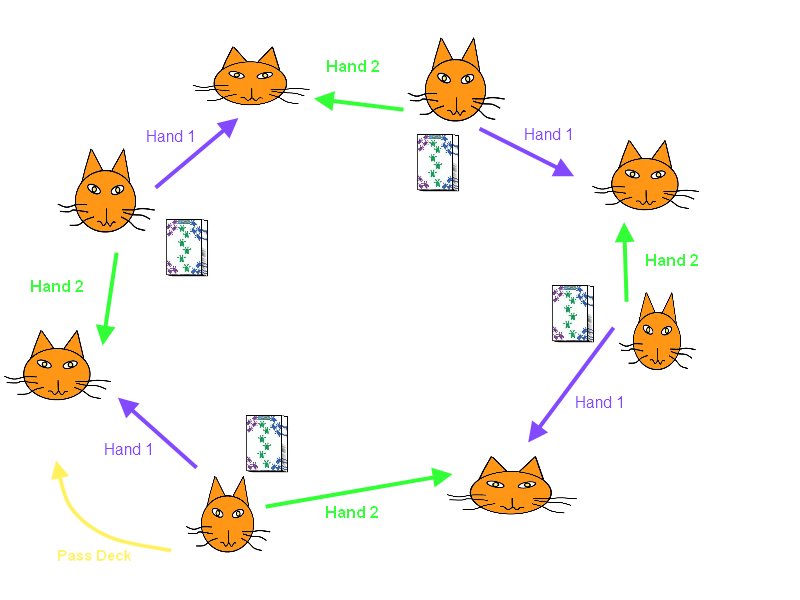 |
| With an even number of players and enough Piquet decks, every player can be playing a hand simultaneously. |
Piquet à Ecrire: Piquet à Ecrire is a method to allow a Piquet gaming session with a larger number of players. To begin, one player should be selected as the first dealer. This player would then first deal and play a hand of standard two-handed Piquet to the player to his left and then a second hand with the player to his right. The play of the hand is identical to standard two-player Piquet described above.
After the dealer has played these two hands, the deck passes to the next player to the left, who then also deals and plays a hand to the player to his immediate left and then another hand against the opponent to his right (which would include the immediately previous dealer). This continues until every player has had the opportunity to deal two hands, concluding the game.
If there is an even number of players at the table, the game can be sped up somewhat and allow more active players at the same time. This can be done with every alternate player around the table might be given their own deck.
Thus, the game would be played out in four total deals. After the first set of players dealt and played two hands, they would then pass the deck to the player to their left who would then also deal two hands. After the second two hands, each player should have had the opportunity to deal two hands.
This works out very nicely if there is an even number of players, as all players would be playing simultaneously. Since with an odd number of players, there will be one player who is not playing at any given time, usually just the one deck is used and passed around the table in turn.
During play, each player would keep a running total of their score over all their hands played. At the conclusion of the game, each player would then determine their total "game" points based on the difference between their score and each other player (adding or subtracting points from their total). The player with the highest number of game points would be considered the game winner.
Original Rules: Although the two handed version of Piquet played today is very similar to the original game, there are a number of differences which have been adapted over the centuries. The following is an even closer approximation to these original rules.
The deck used for classic rules consists of the following denominations from a standard 52 card deck (in order of ranking from high to low); Ace, King, Queen, Jack, 10, 9, 8, 7, 6. After determination of the first dealer (which is usually by the draw of low card from the shuffled deck), the cards are shuffled, cut and then dealt in packets of two face-down cards to each player until both players each have 12 cards total. The remainder of the deck (consisting of 12 more cards) is placed face down in a stack in the center of the table.
A player with a hand containing no face cards is said to have a blank, which may earn the player bonus points.
If the non-dealer has such a hand, they would then declare this and also indicate how many cards they intend to discard (minimum of 1, maximum of 8). After a declaration of blank, the player then shows their hand to verify they actually do have a blank. However, if the dealer also has a blank, they would then also declare this and indicate how many cards they intend to discard. In this case the dealer would also show his hand, and neither player would score for the blank. However, if only the non-dealer has a blank (and the dealer does not), the non-dealer would then score 10 points. If both players have a blank, no one scores for the blank. The dealer can never score for a blank, even if the dealer is the only player to have a blank during the hand, however he is also not obligated to show his hand in this circumstance since he cannot score for the blank.
After any declarations for blank and indication of cards they intend to draw, the players would then discard the appropriate number of cards face down and draw the same number. The non-dealer draws first and must discard and draw at least one, and may replace up to a maximum of 8. The dealer has the same options. however, if there are fewer than 8 cards remaining in the stock, they may obviously only discard and draw up to a maximum of the number left in the stock.
After the draw, similar to the standard game, the players then perform the other point scoring declarations; Ruff, Sequence and Set.
Ruff is the first category of declaration and consists of a declaration of the total number of points a player has in their largest suit. The point values of cards in the suit are as follows:
| Card | Ruff Point Value |
|---|
| Ace | 11 |
| King, Queen, Jack | 10 |
| 9, 8, 7, 6 | Value marked on card |
|
|
|
The non-dealer would declare their highest number of points in a single suit. If the dealer has a ruff with an equal or higher number of total points in the suit, they would make a declaration of that as well. The player with the highest ruff would then score 1 point for each 10 points in card values comprising the ruff. Points in the ruff are rounded appropriately (5 or lower round down, 5 to 9 round up). If both players have ruffs of equal values, neither player scores for the ruff. The opponent of a player scoring for the Ruff category may ask to see the Ruff and a player so asked must oblige.
The next category of declarations would be for
Sequence. The non-dealer again speaks first, making a declaration of the number of cards in their longest sequence. A sequence is a continuous series of cards in the same suit and must consist of three or more cards. If the non-dealer has no such Sequence, they would simply indicate "No Sequence". After the non-dealer makes their declaration, the dealer would then make their own. The player having the longest such Sequence would then score depending on the number of cards in the sequence. A sequence consisting of 3 cards scores 3, one of 4 cards scores 4 and a sequence of 5 or more cards scores 10 plus the number of cards in the sequence. If both players have a sequence of equal length, the sequence with the highest top card is considered the highest. If both sequences are of equal length and have the same high card, no one scores in the Sequence category for the hand. The player who has the highest sequence and scores accordingly, may also score for any additional sequences in their hand. They must also, on demand, show their winning sequence.
The last category of declaration in the game is for
Set. A set is a group of three or more cards in a denomination of 10 or higher. The non-dealer declares first, indicating the number of cards in their largest set. If a player has no such set, they would simply indicate "No Set". If the dealer has a set containing an equal or higher number of cards as the non-dealer they would then declare it. The player with the highest set would score 3 points for a set of 3 cards and 14 for sets of 4 cards. If both players have sets of equal length, the set in the higher denomination would be considered the higher set. The player winning in the Set category can score for each additional set in their hand. As in all other categories, the player winning in the category must show the winning set if requested by the opponent.
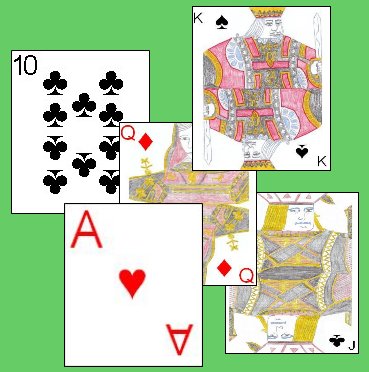 |
| Cards with a denomination of 10 or higher can earn one point when led to a trick. |
After the declaration stage of the game is complete, the Trick portion of the hand begins. This is played identically to the two-hand version described above. Each player plays a card to the trick, and the highest card of the suit led to the trick wins the trick. The non-dealer leads the first card to the first trick and the winner of each trick leads to the next, for a total of 12 tricks played.
Points are earned during this phase for leading or winning certain tricks. Any playing leading a card of denomination ten or higher to a trick earns one point instantly. One point is also earned for winning a trick. Winning the last trick using a card of denomination of 10 or higher earns the player two points. If winning the last trick using a card of denomination less than a 10, the player earns one point.
After all tricks have been played, the players count the number of tricks won during the hand. If a player manages to win all 12 tricks (called Capet) they earn 60 points. A player winning 7, 8, 9, 10 or 11 tricks earns 10 points.
If a player manages to score 30 points during the trick playing phase before their opponent has earned any, he earns a bonus of 30 points. This is called Picy.
A player earning 30 points, before his opponent has scored any before the trick winning portion of the game, earns a bonus of 60 points. This is called Repicy. In order to earn these bonuses, the player must declare them before the end of the hand.
The first player to reach or exceed 100 points, during or at the completion of a hand is declared the winner of the game.
Imperial: Imperial, also called Piquet Imperial, Trump Piquet and Vingt-Quatre is a variant of Piquet that is a combination of straight Piquet and early forms of Whist. Some refer to it as Piquet with a trump as the game plays much like Piquet, but Imperial also includes designation and use of a Trump suit.
As in the standard game, Imperial is designed for two players using the regular 32 card Piquet deck. The ranking of the cards in Piquet Imperial is as follows, from high to low; King, Queen, Jack, Ace, 10, 9, 8, 7. However, some players more familiar with the original game of standard Piquet prefer to use the ranking of cards as per standard Piquet rules. Before beginning the game two piles of chips are usually provided in the center of the table. One of the piles contains nine red chips and the other contains 12 white chips. Each red chip is equivalent to six white chips. The deal is the same as in the standard game with each player receiving 12 face down cards to form their hand. However, after each player receives his full detail of cards, the next card from the deck is dealt face up to designate the trump suit for the hand. This card is then set perpendicular under the remainder of the face down deck. If this turned up card is any King, Queen, Jack, 10 or 7 (called an Honour) the dealer immediately scores one white chip, taking a white chip from the center pile and adding it in a pile in front of himself. If this turned over card is a King or Ace, the dealer may, if he holds the seven of the Trump suit in his hand, exchange the Seven for the turned up card.
Unlike the standard game, there is no card discards or draws, so after the initial deal, the declaration phase proceeds. As a hand containing Carte-Blanche may score for it during the declaration phase, having such a hand is not immediately stated. The turned up trump card (or the seven if exchanged by the non-dealer) is also considered an extra card in each players hand for determination of the declarations. The declarations are made in Imperial Piquet in the following order:
- Imperials: The second series of declarations is for any Imperials held by a player. A player scores for each set or combination making an Imperial in his hand regardless of what his opponent also scores for. The following is the complete list of combinations which can be used to make an Imperial:
| Name | Description | Value | Showing Order |
|---|
| Imperiale D'atout | King, Queen, Jack, Ace of Trump Suit | 2 Red Chips | 1 |
| Imperiale | King, Queen, Jack, Ace of same suit (Non-Trump) | 1 Red Chip | 2 |
| Imperiale D'Honneur | All Four Aces, Four Kings, Four Queens, Four Jacks or Four 7's | 1 Red Chip | 3 |
| Imperiale Blanche | A 12 card hand containing no Kings, Queens or Jacks | 2 Red Chips | 4 |
|
|
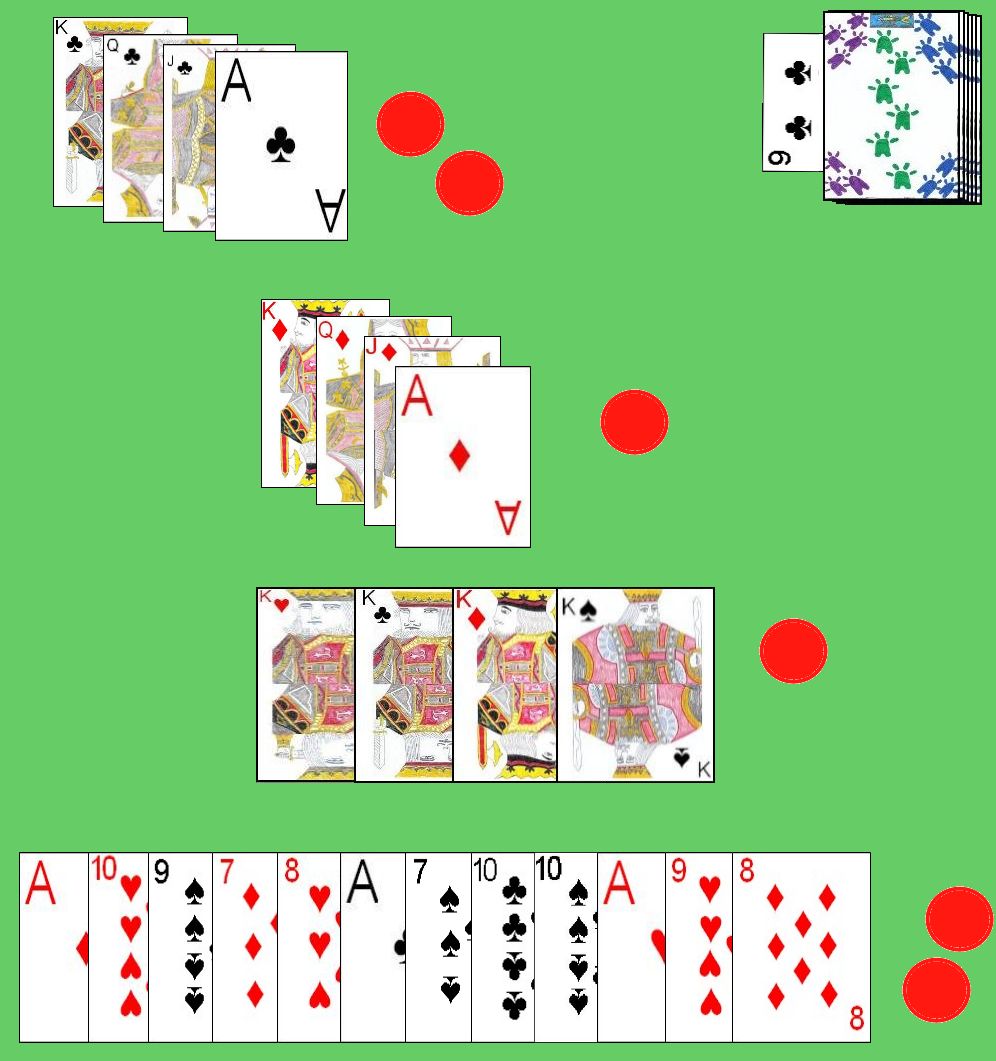 |
The Imperials are declared in the indicated showing order, with non-dealer declaring first in each category. If requested by his opponent, a player must display any cards for which he declares for.
- Point: In Imperial Piquet, Point is scored similarly to the standard game. Whichever player has the highest sum total of cards in one single suit scores one white chip. The values for the individual cards for purposes of calculating Point is the same as in the standard game; Aces 11, Face cards 10, all other cards the value marked on the card. If both players have an equal highest total in their highest suit, the non-dealer receives the chip for Point. As noted, the turned up card is also considered to be a member of each players hand for purposes of declarations. The procedure for declaring for Point should be done the same as in standard Piquet.
After the declaration phase, play of the hand starts, with the non-dealer leading to the first trick. When playing to a trick, a player must play a card of the same suit as led, if they have won. In addition, they must attempt to win the trick, playing a higher card of the suit led if they have one. If they do not have a card of the suit led, they must play a trump card to the trick. If they have neither a card of the suit led or a trump suit, they may play any card to the trick. The highest card of the trump suit in the trick wins it, but if the trick contains no cards of the trump suit, the highest card of the suit originally led to the trick wins it. The winner of each two card trick leads the first card to the next trick. Cards played to tricks are not actually played to the center of the table but rather played face up directly in front of the player.
During the play of the hand, each honour captured in tricks scores one white chip. At the end of the hand, each trick a player has won in excess of six earns that player one white chip. However, if a player was able to capture all 12 tricks, he wins 2 red chips instead. If both players win exactly 6 tricks, neither players wins any bonus for extra tricks.
If a player, while scoring accumulates six white chips, they trade these white chips back to the center in exchange for one red chip (called an Imperial). At any time in the game, when scoring, if a player gets a red chip (either directly or by trading in six white chips), all white chips held by the opponent must be replaced back into the center pile (with no exchange of red chips). However, there is one exception to this rule. If a player earns a red chip through declaring for Imperiale Blanche, the opponent is not obligated to return his white chips to the center pile. All scoring should be done in the strict order as indicated in these rules. The first player to capture five red chips is instantly declared the winner of the game.
Copyright © 2015 CatsAtCards.com. All rights reserved.
 Piquet is thought to be the one of the oldest games of cards still played today largely in its original form. Originally a French pastime, this game is known to have been played in France well over 450 years ago.
Piquet is thought to be the one of the oldest games of cards still played today largely in its original form. Originally a French pastime, this game is known to have been played in France well over 450 years ago.







